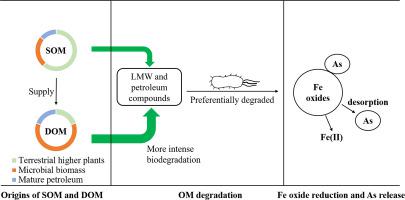Chemical Geology ( IF 3.9 ) Pub Date : 2022-09-29 , DOI: 10.1016/j.chemgeo.2022.121140 Jianyi Jin, Huaming Guo, Zhipeng Gao, Ruoyu Mao, Hai Lu

|
Organic matter plays important roles in arsenic mobility. Whether sedimentary or dissolved organic matter is the predominant electron donors is still on debate. To fill this gap, both sediments and groundwater were collected from the Hetao Basin, a typical arid-semiarid area hosting high arsenic groundwater, to characterize diagnostic biomarkers and compound-specific carbon isotopes of lipids in dissolved organic matter (DOM) and its depth-matched sedimentary organic matter (SOM). Results showed that SOM in both clay and sand layers were mainly sourced from terrestrial higher plants, but sand SOM had additional sources from microbial and petroleum OM. Compound-specific carbon isotope compositions of DOM and SOM showed that δ13C of low molecular weight (LMW) n-alkanes (δ13CL) were more positive than those of high molecular weight (HMW) n-alkanes (δ13CH). The δ13CH in groundwater (δ13CH-DOM) and sediments (δ13CH-SOM) fall in the range of C3 plants, indicating that DOM and SOM had similar origins. More positive δ13CL than δ13CH suggests preferential degradation of LMW compounds in both sediments and groundwater. In comparison with SOM, more microbial-derived OM was observed in groundwater DOM, especially in high‑arsenic groundwater. High arsenic groundwater was accompanied by the low ratio of n-alkanes to hopanes in depth-matched SOM, and the great difference between δ13CL and δ13CH and low terrestrial/microbial ratios (TAR) in groundwater DOM. This indicates that SOM and DOM should be utilized by indigenous bacteria to fuel the reductive dissolution of Fe oxides for arsenic release into groundwater. Furthermore, more abundant LMW compounds and weaker odd-to-even predominance in DOM than those in SOM support that DOM encountered stronger biodegradation. This study highlights that preferential biodegradation of DOM (especially LMW components and petroleum sourced OM) would provide electrons for the reductive dissolution of arsenic-bearing Fe/Mn oxides and thus induce arsenic enrichment in groundwater.
中文翻译:

高砷地下水系统中溶解有机物和沉积有机物的生物降解:来自脂质生物标志物和化合物特异性碳同位素的证据
有机物在砷迁移中起重要作用。沉积物还是溶解有机物是主要的电子供体仍然存在争议。为了填补这一空白,河套盆地是一个典型的高砷地下水的干旱半干旱地区,收集了沉积物和地下水,以表征溶解有机物 (DOM) 中脂质的诊断生物标志物和化合物特异性碳同位素及其深度。相匹配的沉积有机质(SOM)。结果表明,粘土层和砂层中的有机质主要来源于陆生高等植物,而沙层有机质还有微生物和石油有机质的来源。DOM 和 SOM 的化合物特异性碳同位素组成表明,低分子量 (LMW) 正构烷烃的 δ 13 C ( δ 13 CL ) 比高分子量 (HMW) 正构烷烃 (δ 13 C H ) 更积极。地下水(δ 13 C H - DOM)和沉积物(δ 13 C H-SOM )中的δ 13 C H在C3植物范围内,表明DOM和SOM具有相似的起源。δ 13 C L比 δ 13 C H更正表明LMW化合物在沉积物和地下水中的优先降解。与 SOM 相比,在地下水 DOM 中观察到更多的微生物来源的 OM,尤其是在高砷地下水中。高砷地下水伴随着深度匹配的 SOM 中正构烷烃与藿烷的低比例,以及 δ 13 C L和 δ 13 C H之间的巨大差异和地下水 DOM 中的低陆地/微生物比率 (TAR)。这表明本地细菌应利用 SOM 和 DOM 来促进 Fe 氧化物的还原溶解,从而将砷释放到地下水中。此外,与 SOM 相比,DOM 中更丰富的 LMW 化合物和更弱的奇偶优势表明 DOM 遇到了更强的生物降解。该研究强调,DOM(尤其是 LMW 组分和石油来源的 OM)的优先生物降解将为含砷 Fe/Mn 氧化物的还原溶解提供电子,从而导致地下水中的砷富集。


























 京公网安备 11010802027423号
京公网安备 11010802027423号